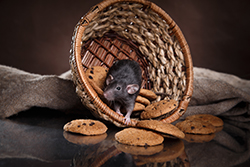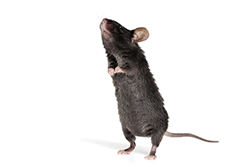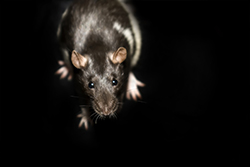Roof Rats Pest Control
Call Now: (888) 499-7378
Schedule an Appointment Online
ApolloX Pest Control will remove roof rats from your home quickly, efficiently, and safely.
Roof Rats Pest Control: Rodent Extermination Demonstration
 Roof Rats Pest Control: Identifying Roof Rats
Roof Rats Pest Control: Identifying Roof Rats
Roof rats, sometimes called black rats, are slightly smaller than Norway rats. The typical roof rat is between 13 to 18 inches long, including its tail. In fact, it is distinguished from other rats by that tail, which is longer than the rest of its body. Roof rats are sleek, slender, and agile. Their have large ears.
 Roof Rats Pest Control: Where Roof Rats Live and Breed
Roof Rats Pest Control: Where Roof Rats Live and Breed
Roof rats are agile climbers and usually live and nest above ground in shrubs, trees, and dense vegetation such as ivy. In buildings, they are most often found in enclosed or elevated spaces such as attics, walls, false ceilings, and cabinets.
Once roof rats have invaded your garden or landscaping, unless your house is truly rodent proof, it is only a matter of time before you find evidence of them indoors. Roof rats can gain entry to structures by gnawing, climbing, jumping, or swimming through sewers and entering through toilets or broken drains. Roof rats, especially young rats, can squeeze beneath a door with only a 1/2-inch gap. If the door is made of wood, the rat might gnaw to enlarge the gap, but this might not be necessary.
 Roof rats eat a wide variety of foods, but they prefer fruits, nuts, berries, slugs, and snails. Roof rats are especially fond of avocados and citrus. Their favorite habitats are attics, trees, and overgrown shrubbery or vines. Roof rats prefer to nest in locations off the ground and rarely dig burrows for living quarters if off-the-ground sites exist.
Roof rats eat a wide variety of foods, but they prefer fruits, nuts, berries, slugs, and snails. Roof rats are especially fond of avocados and citrus. Their favorite habitats are attics, trees, and overgrown shrubbery or vines. Roof rats prefer to nest in locations off the ground and rarely dig burrows for living quarters if off-the-ground sites exist.
Roof rats routinely travel up to 300 feet for food. They can live in the landscaping of one residence and feed at another. They often can be seen at night running along overhead utility lines or fence tops. They have an excellent sense of balance and use their long tails to steady themselves while traveling along overhead utility lines. They move faster than Norway rats and are very agile climbers, which enables them to quickly escape predators. They can live in trees or in attics and climb down to a food source. The average number of litters a female roof rat has per year depends on many factors, but generally it is 3 to 5 with 5 to 8 young in each litter.
 Roof rats, like house mice, are active mostly at night. They have poor eyesight, but they make up for this with their keen senses of hearing, smell, taste, and touch. Roof rats constantly explore and learn, memorizing the locations of pathways, obstacles, food and water, shelter, and features of their environment. They quickly detect and tend to avoid new objects and novel foods. Thus, they often avoid traps and baits for several days or more following their initial placement.
Roof rats, like house mice, are active mostly at night. They have poor eyesight, but they make up for this with their keen senses of hearing, smell, taste, and touch. Roof rats constantly explore and learn, memorizing the locations of pathways, obstacles, food and water, shelter, and features of their environment. They quickly detect and tend to avoid new objects and novel foods. Thus, they often avoid traps and baits for several days or more following their initial placement.
Inspect your yard and home thoroughly. If the answer to any of the following questions is yes, you may have a roof rat problem.
- Do you find rat droppings around dog or cat dishes or pet food storage containers?
- Do you hear noises coming from the attic just after dusk?
- Does your dog or cat bring home dead rat carcasses?
- Is there evidence rodents are feeding on fruit/nuts that are in the trees in your yard?
- Are there smudge marks caused by the rats rubbing their fur against beams, rafters, pipes, and walls?
 Roof Rats Pest Control: Damage, Harm Caused by Roof Rats
Roof Rats Pest Control: Damage, Harm Caused by Roof Rats
Roof rats eat and contaminate foodstuffs and animal feed. They also damage containers and packaging materials in which foods and feed are stored. Roof rats cause problems by gnawing on electrical wires and wooden structures such as doors, ledges, corners, and wall material, and they tear up insulation in walls and ceilings for nesting.
If roof rats are living in the attic of a residence, they can cause considerable damage with their gnawing and nest-building activities. They also damage garden crops and ornamental plantings.
Among the diseases roof rats can transmit to humans or livestock are murine typhus, leptospirosis, salmonellosis (food poisoning), and ratbite fever. Plague is a disease that roof rats can carry.
Roof Rats Pest Control
Call Now: (888) 499-7378
Schedule an Appointment Online
See Also:















Recent Comments